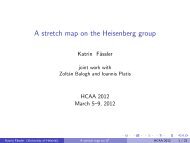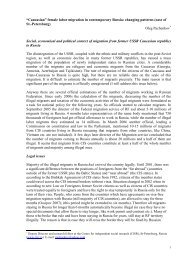324 TRANSACTIONS OF THE PHILOLOGICAL SOCIETY 109, 2011 Table 2. Possible fillers <strong>in</strong> Motion, Location and Possession <strong>metaphors</strong> Motion Location Possession morbus morbus morbus <strong>in</strong>vidia <strong>in</strong>vidia <strong>in</strong>vidia aegritudo aegritudo aegritudo dubium dubium dubium febris febris <strong>in</strong>sania <strong>in</strong>sania ira ira odium odium fames fames dementiam rabiem memoria metus metus gaudium gaudium desiderium desiderium dolor dolor timor terror maestitia maeror frigus fastidium sitis pudor verecundia laetitia alternative to express <strong>in</strong>choative processes and a valid strategy for impos<strong>in</strong>g a dynamic perspective on stative feel<strong>in</strong>gs. After all, this alternation <strong>in</strong> cod<strong>in</strong>g strategies is to be expected <strong>in</strong> semantic fields concern<strong>in</strong>g experience, because the Experiencer–Stimulus relations show a wide variation of argument l<strong>in</strong>k<strong>in</strong>g patterns and alternative metaphorical ways of conceptualiz<strong>in</strong>g the same experience (e.g. Bossong 1998; Croft 1998; Verhoeven 2007). Usually, languages do not limit themselves to a s<strong>in</strong>gle syntactic option to conceptualise a situation with a one-to-one mapp<strong>in</strong>g between function and form, but <strong>in</strong>stead display a wide <strong>in</strong>ventory of lexical and syntactic strategies that allow a given situation to be portrayed <strong>in</strong> alternative ways (see Langacker 1991: 330). Conceivably, limits to variation do exist: <strong>in</strong> our case, for <strong>in</strong>stance, the fact that timor ‘fear’, terror ‘fright’, pavor ‘fear’ and frigor ‘cold’ only occur with the Location schema tells us that fear and cold were preferably conceived of as conta<strong>in</strong>ers ‘placed’ <strong>in</strong> the real world. Thus, the aspectual focus was cast on their stativity, durativity and atelicity, apparently exclud<strong>in</strong>g any type of <strong>in</strong>choative read<strong>in</strong>g. This shows that, generally speak<strong>in</strong>g, experiential <strong>metaphors</strong> and grammatical constructions tend to be associated along preferred paths. In conclusion, <strong>in</strong> this article I have shown that tools provided by the cognitivist framework can shed considerable light on the synchronic and diachronic organization of a specific metaphorical doma<strong>in</strong>, even for a ‘dead’ language such as Lat<strong>in</strong>. From a theoretical perspective, the present cognitivist corpus-based study has allowed (i) to cover a wider range of data; (ii) to shed light on a patterned variation <strong>in</strong> Lat<strong>in</strong> experiential <strong>metaphors</strong>, and to show that this variation is not randomly but rather conceptually motivated; (iii) to systematically describe some metaphoric networks <strong>in</strong> terms of productivity and schematicity, and to <strong>in</strong>dividuate which patterns worked as models for further extensions; (iv) to identify semantic and aspectual constra<strong>in</strong>ts <strong>in</strong> the applicability of different sources to different target doma<strong>in</strong>s, i.e. to highlight emotion-specific <strong>metaphors</strong> (cf. Stefanowitsch 2005b); and (v) to provide evidence for the cross-cultural reality of metaphorical mapp<strong>in</strong>gs, which suggested that an experience can be metaphorically conceptualised <strong>in</strong> the same way across both space and time.
The challenge was to check whether apply<strong>in</strong>g (psycho)l<strong>in</strong>guistic notions such as frequency, schematicity and entrenchment could be useful <strong>in</strong> order to adequately describe a structured <strong>in</strong>ventory of <strong>metaphors</strong> from a dead language, and I hope to have shown that this theoretical question has a positive answer. Dipartimento di L<strong>in</strong>guistica teorica e applicata Universita` di Pavia Corso Strada Nuova 65 I-27100 Pavia, Italy Email: chiara.fedriani@unipv.it FEDRIANI – EXPERIENTIAL METAPHORS IN LATIN 325 References ATHANASIADOU, ANGELIKI & TABAKOWSKA, ELZBIETA (eds), 1998. Speak<strong>in</strong>g of Emotions: Conceptualisation and Expression, Berl<strong>in</strong>: Mouton de Gruyter. BALDI,PHILIP, 2002. ‘Where does Lat<strong>in</strong> habeo come from?’, <strong>in</strong> Fabrice Cavoto (ed.), A Festschrift for Alexis Manaster- Ramer, Munich: L<strong>in</strong>com Europa, 23–32. BALDI, PHILIP &NUTI, ANDREA, 2010. ‘Possession’, <strong>in</strong> Philip Baldi & Pierluigi Cuzzol<strong>in</strong> (eds), New Perspective on Historical Lat<strong>in</strong> Syntax, Berl<strong>in</strong>: Mouton de Gruyter, 239–388. BARðDAL, JO´ HANNA, 2008. Productivity: Evidence from Case and Argument Structure <strong>in</strong> Icelandic, Amsterdam: Benjam<strong>in</strong>s. BENVENISTE, EMILE, 1960. ‘‘‘Eˆ tre’’ et ‘‘avoir’’ dans leurs fonctions l<strong>in</strong>guistiques’, Bullet<strong>in</strong> de la Socie´te´ l<strong>in</strong>guistique de Paris 55, 113–34; repr. <strong>in</strong> E. Benveniste, Proble`mes de l<strong>in</strong>guistique ge´ne´rale I (Paris: Gallimard 1966), 187–207. BOERS, FRANK, 1996. Spatial Prepositions and Metaphor: A Cognitive Semantic Journey along the UP–DOWN and the FRONT–BACK Dimension, Tu¨b<strong>in</strong>gen: Narr. BOSSONG, GEORG, 1998. ‘Le marquage de l’experient dans les langues de l’Europe’, <strong>in</strong> Jack Feuillet (ed.), Actance et valence dans les langues de l’Europe, Berl<strong>in</strong>: Mouton de Gruyter, 259–94. CLAUSNER, TIMOTHY C. & CROFT, WILLIAM, 1997. ‘Productivity and schematicity <strong>in</strong> <strong>metaphors</strong>’, Cognitive Science 21(3), 247–82. CROFT,WILLIAM, 1998. ‘Event structure <strong>in</strong> argument l<strong>in</strong>k<strong>in</strong>g’, <strong>in</strong> Miriam Butt & Wilhelm Geuder (eds), The Projection of Arguments: Lexical and Compositional Factors, Stanford, CA: CSLI, 21–63. CROFT, WILLIAM, 2001. Radical Construction Grammar: Syntactic Theory <strong>in</strong> Typological Perspective, Oxford: Oxford University Press. CROFT, WILLIAM &CRUSE, ALAN D., 2004. Cognitive L<strong>in</strong>guistics, Cambridge: Cambridge University Press. DA˛ BROWSKA, EWA, 2004. Language, M<strong>in</strong>d and Bra<strong>in</strong>: Some Psychological and Neurological Constra<strong>in</strong>ts on Theories of Grammar, Ed<strong>in</strong>burgh: Ed<strong>in</strong>burgh University Press. DEIGNAN, ALICE, 2005. Metaphor and Corpus L<strong>in</strong>guistics, Amsterdam: Benjam<strong>in</strong>s. EMANATIAN, MICHELE, 1992. ‘Chagga ‘‘come’’ and ‘‘go’’: metaphor and the development of tense-aspect’, Studies <strong>in</strong> Language 16(1), 1–33. ERNOUT, ALFRED &THOMAS, FRANC¸ OIS, 1972 [1951]. Syntaxe lat<strong>in</strong>e, Paris: Kl<strong>in</strong>cksieck. GARCI´ A-HERNÁNDEZ, BENJAMIN, 1989. ‘Les preverbes lat<strong>in</strong>s: notions latives et aspectuelles’, <strong>in</strong> Marius Lavency & Dom<strong>in</strong>ique Longree (eds), Actes du V-e Colloque de L<strong>in</strong>guistique lat<strong>in</strong>e, Louva<strong>in</strong>-la-Neuve: Peeters, 149–59. GIBBS, RAYMOND &STEEN, GERARD (eds), 1999. Metaphor <strong>in</strong> Cognitive L<strong>in</strong>guistics, Amsterdam: Benjam<strong>in</strong>s. GOLDBERG, ADELE, 1995. Constructions: A Construction Grammar Approach to Argument Structure, Chicago: University of Chicago Press. GUMMERE, RICHARD M., 1917-25. Lucius Annaeus Seneca: Moral Epistles, 3 vols, Loeb Classical <strong>Library</strong>, Cambridge, MA: Harvard University Press. HASPELMATH, MARTIN, 2001. ‘Non-canonical mark<strong>in</strong>g of core arguments <strong>in</strong> European languages’, <strong>in</strong> Alexandra Aikhenvald, Robert M.W. Dixon & Masayuki Onishi (eds), Non-canonical Mark<strong>in</strong>g of Subjects and Objects, Amsterdam: Benjam<strong>in</strong>s, 53–83. HAVERLING, GERD, 2000. ‘On sco-verbs, prefixes and semantic functions: a study <strong>in</strong> the development of prefixed and unprefixed verbs from Early to Late Lat<strong>in</strong>’, Gothenburg: Acta universitatis Gothoburgensis. HEINE, BERND, 1997. Possession: Cognitive Sources, Forces, and Grammaticalization, Cambridge: Cambridge University Press. KO¨ NIG, EKKERARD & HASPELMATH, MARTIN, 1998. ‘Les constructions à possesseur externe dans les langues de l’Europe’, <strong>in</strong> Jack Feuillet (ed.), Actance et valence dans les langues de l’Europe, Berl<strong>in</strong>: Mouton de Gruyter, 525– 606. KO¨ VECSES, ZOLTA ´ N, 2000. Metaphor and Emotion: Language, Culture and Body <strong>in</strong> Human Body, Cambridge: Cambridge University Press. KO¨ VECSES, ZOLTA ´ N, 2002. Metaphor: A Practical Introduction, Oxford: Oxford University Press. LAKOFF, GEORGE, 1987. Women, Fire, and Dangerous Th<strong>in</strong>gs: What Categories Reveal about the M<strong>in</strong>d, Chicago: University Press.

















